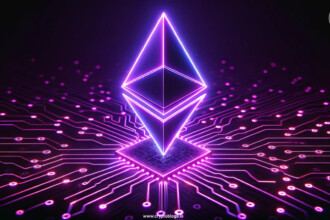The evolution of blockchain technology has given rise to several innovative platforms but none have embraced the idea of interoperability as deeply as Cosmos and Polkadot. These two giant blockchain infrastructures aim to solve one of the most critical challenges in the blockchain landscape – the inter-blockchain connectivity. This facility ensures that different blockchain networks can communicate and share value seamlessly with one another. While both platforms focus on a multi-chain ecosystem, their approaches and architectures differ from the fundamentals.
This blog will explore the key distinctions between Cosmos and Polkadot, examine their futures, and offer insights into how they shape the future of interoperability. Let’s get into it;
Cosmos: The Internet of Blockchains
Cosmos – often referred to as the “Internet of Blockchains” – is designed to address the scalability and interoperability challenges faced by traditional blockchain networks. It uses a unique Tendermint consensus algorithm and the Cosmos SDK, allowing developers to create custom blockchains that are part of a larger ecosystem. The Inter-Blockchain Communication Protocol (IBC) serves as the backbone of Cosmos which enables seamless communication between independent blockchains.
Key features of Cosmos:
- Scalability: Cosmos allows individual blockchains (or called “Zones”) within its ecosystem to operate independently. This feature enables each Zone to achieve horizontal scalability.
- Modularity: Developers can build and customize blockchains using the Cosmos SDK. Using this customized SDK, developers can design application specific blockchain networks.
- IBC Protocol: The Inter Blockchain Communication (IBC) protocol facilitates communication and transactions across multiple blockchains launched as “Zones” in the Cosmos ecosystem.
Polkadot: A Heterogeneous Multi-Chain Network
Polkadot takes a slightly different approach to achieve interoperability than Cosmos. It is considered a heterogeneous multi-chain network, meaning that it supports multiple blockchains with varying structures. Polkadot was created by one of the Ethereum co-founder and developer Dr.Gavin Wood.
Its key innovation is the Relay Chain, which is the central hub that connects various specialized blockchains – known as parachains. These parachains can have unique functionalities while still benefiting from Polkadot’s shared security model.
Key features of Polkadot:
- Parachains: Parachains are independent blockchain networks that are developed using Polkadot’s infrastructure. These networks are optimized for specific use cases.
- Shared Security: All these parachains inherit security of the main Relay Chain.
- On-Chain Governance: Polkadot allows DOT token holders to vote on protocol upgrades without hard forks.
Differences Between Cosmos and Polkadot
| Cosmos | Polkadot | |
| Architecture | Focuses on building independent blockchains that communicate through the IBC protocol. Each chain maintains its own governance, consensus, and security. | Uses a Relay Chain to connect parachains, offering shared security and governance through its central hub. |
| Consensus Mechanism | Relies on the Tendermint consensus mechanism, which is fast and efficient but doesn’t enforce shared security across networks. | Implements Nominated Proof of Stake (NPoS), ensuring a higher level of security by linking parachains to the Relay Chain. |
| Interoperability Approach | Utilizes the IBC protocol, which is permissionless and allows for direct communication between chains. However, chains must opt into this model. | Facilitates interoperability via the Relay Chain but requires blockchains to become parachains, potentially limiting the flexibility compared to Cosmos. |
| Governance | Governance is decentralized, with each blockchain making independent decisions. | Provides on-chain governance through its Relay Chain, allowing the community to vote on network upgrades without forks. |
| Security | Chains must secure themselves independently, which can lead to varying levels of security. | Offers pooled security for all parachains, as they share the Relay Chain’s security framework. |
Future of Interoperability
Both Cosmos and Polkadot are well-positioned to shape the future of blockchain interoperability. The open-ended architecture of Cosmos allows for a more permissionless and modular ecosystem. This could be advantageous for developers seeking full autonomy. On the other hand, Polkadot’s shared security model may offer a more secure environment for dApps and enterprises looking for robust infrastructure.
However, the future may not see a clear winner. Instead, these two ecosystems could co-exist as independent blockchain infrastructures. Cosmos could be focusing on loosely connected modular blockchain platforms while Polkadot could provide a more cohesive, secure, and integrated multi-chain system. Both platforms are likely to expand in future with more projects building on their infrastructures. This way, both can contribute to a growing world of interoperable blockchains.
Conclusion
In the battle of Cosmos vs Polkadot, both ecosystems bring unique strengths to the table. Cosmos offers unparalleled flexibility with its independent blockchain model, while Polkadot’s shared security and unified governance stand out as its primary advantages. As blockchain technology continues to evolve, the need for seamless interoperability will only grow. Both the Cosmos and Polkadot are set to be key players in this transformative journey.
Ultimately, the choice between Cosmos and Polkadot comes down to specific use cases and needs. Developers and businesses may opt for Cosmos when independence and customizability are critical, while Polkadot may be the better choice for projects that prioritize security and integration within a unified ecosystem.
Related Blogs:
- Crypto Coins vs Tokens – Understanding the Difference
- Hyperledger Fabric Vs. Public Blockchain
- CEX vs DEX: Guide To Centralized And Decentralized Crypto Exchanges







